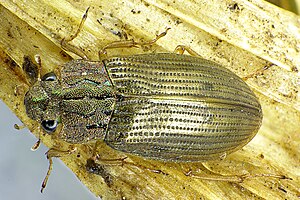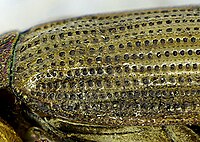Helophorus grandis
| Helophorus grandis | ||||||||||||
|---|---|---|---|---|---|---|---|---|---|---|---|---|

Helophorus grandis |
||||||||||||
| Systematics | ||||||||||||
|
||||||||||||
| Scientific name | ||||||||||||
| Helophorus grandis | ||||||||||||
| ( Illiger , 1798) |
Helophorus grandis is a beetle from the family of the water beetles (Hydrophilidae) and the subfamily Helophorinae . The genus Helophorus is represented in Europe with eight subgenus , Helophorus grandis belongs to the subgenus Helophorus , which is represented in Europe with seven species. The species Helophorus maritimus was previously listed under the name Helophorus grandis maritimus as a subspecies of Helophorus grandis . However, it was placed on the same level as the species, as Helophorus grandis and Helophorus maritimus have different karyograms .
The generic name Helophorus from ancient Greek ήλος 'hēlos' 'nail, hump' and φωρῶς 'phorós' 'bearing' names the elevations on the pronotum. The species name grandis from Latin grándis means 'large' and refers to the relatively large body. The common German name for the species-rich genus is 'Furchenwasserkäfer'.
 Fig. 1: Lateral wing covers in the area of the shoulders |
  Fig. 2: End of the abdomen from below above H.grandis below H.aquaticus |
 Fig. 3: End of the left jaw probe top view |
Characteristics of the beetle
The beetle is six to nine millimeters long and yellow-brown, but the color is often distorted by soiling. The head and pronotum usually have a greenish tinge. The beetle is elongated oval when viewed from above and flat below and arched above when viewed from the side.
The four-section lower jaw probes with a very small base section protrude far beyond the outline of the head. Your last link is not symmetrical to the longitudinal axis, but the inside is almost straight, while the outside is clearly curved outwards (Fig. 3). The mandibles are short and curved. They end in a point and have a small pointed tooth on the inside. The nine-part antennae are deflected on the underside of the head. The two strong base links are followed by three narrow antennae links and a link clinging to the club. The antennae end in a three-part club, the limbs of which appear dull due to the hair.
The species of the genus are easily recognizable by five longitudinal furrows on the pronotum . In the case of Helophorus grandis , the spaces between them are uniformly coarse and completely granulated, the grains do not flow together.
The elytra have clear rows of coarse points . The spaces between the rows of points are alternately almost flat and curved. This is particularly visible from the side in the shoulder area (Fig. 1). The row of dots next to the wing cover seam branches off near the base. The resulting greatly shortened row of dots is called a scutellar stripe. Only a part of the species of the genus has a scutellar streak. The elytra can be spotted dark or light.
The rear edge of the last abdominal sternite is much more pronouncedly jagged than that of the similar but smaller Helophorus aquaticus . The prongs are crenellated with clear spaces between them (Fig. 2).
The legs are rather weak. Fore and middle tarsi are four-limbed, the hind tarsus five-limbed. The claw links are long, but the claw link of the hind tarsi is significantly shorter than the other four tarsi together.
larva
The elongated larva has nine fully developed abdominal segments and two long tripartite abdominal appendages. In the third stage, it reaches a length of 9.5 to eleven millimeters and a head width of 1.05 to 1.2 millimeters.
The front edge of the head has a triangular extension in the middle, which forms an apex angle only slightly below 90 ° and whose sides are serrated. On both sides of it sits a forward-facing lobe-shaped appendage, on the front edge of which there are five inwardly curved bristles.
Each abdominal segment has two dorsal and two dorsolateral sclerites on the upper side, symmetrical to one another, and two small point-shaped sclerites on both sides. The smaller of these lies in front of the dorsoventral sclerite, the larger still further in front and further inside. There are two lateral sclerites on each side. Ten sclerites sit on the underside, two of which are arranged medially one behind the other, the others symmetrically on both sides. On the top side of the dorsolateral sclerite there is a breathing opening, the size of which is approximately the size of the larger punctiform sclerite.
The pairs of legs on the three chest sections are rather weak.
biology
The beetle lives in standing or slowly flowing, temporary and warm small bodies of water. The species is a pioneer species of shallow waters, such as those formed in floodplains, but is most often found in puddles, rain barrels, wagon tracks full of water and the like. In a study in France, the frequency of the beetle was negatively correlated with the size of the populated pond. Strongly eutrophic waters with a lot of detritus are preferred, but not boggy waters. The beetle is mainly found in spring, and finds become increasingly rare over the course of summer.
The adults are herbivores, they feed on rotting plant matter and thread algae, but in the laboratory they do not disdain dry peas either. The larvae live in the mud and feed on small insects. They can be fed Tubifex species during breeding .
The species overwinters as an imago, occasionally as a larva. Overwintered adults appear in March and April and open up new habitats with migration flights. They lay their eggs in April and May. The eggs are laid in a cocoon made of silk threads. This consists of a pocket and a narrow extension, which is reminiscent of the leaf blade of a sweet grass and which stands over the pocket like a mast or chimney. The bag contains an egg packet. The cocoon is pushed into the mud on the bank. If the oxygen supply through the fabric of the bag is cut off due to sludge deposits or rising water levels, the oxygen supply takes place via the chimney. The larva hatches after about a week at room temperature. The species only needs about two weeks for the subsequent development, with three larval stages going through. To pupate, the larvae build a pupal chamber. Freshly hatched animals appear from mid-June and also undertake migration flights. The gonads are still underdeveloped in newly hatched animals and only begin to develop to sexual maturity in October and November. Then the pairing takes place. In England, eggs are also laid in November and December, but this is much less common than in spring. In the laboratory, sexual maturity is only reached four to six months after the imago hatches. Animals brought from nature to the laboratory in winter start laying eggs immediately.
distribution
The distribution area stretches from Spain to Scandinavia , the eastern border runs through Sardinia , France , Switzerland , Austria , Germany , Poland , the Baltic States and Finland . In the west, the species reaches Great Britain and Ireland . The species also occurs in the Atlas Mountains . The species has now also been reported from Turkey. The beetle has also been found and is spreading in the United States and Canada .
literature
- Heinz Joy, Karl Wilhelm Harde, Gustav Adolf Lohse: The beetles of Central Europe . tape 3 . Adephaga 2 - Staphylinoidea 1. Goecke & Evers, Krefeld 1971, ISBN 3-87263-015-6 .
- Edmund Reitter : Fauna Germanica, the beetles of the German Empire, Volume II, KGLutz 'Verlag, Stuttgart 1909
- Gustav Jäger (Ed.): CG Calwer’s Käferbuch . K. Thienemanns, Stuttgart 1876, 3rd edition
Individual evidence
- ↑ a b Helophorus grandis at Fauna Europaea. Retrieved April 3, 2012
- ↑ Helophorus at Fauna Europaea. Retrieved April 3, 2012
- ↑ RB Angus: "Separation of Helophorus grandis, maritimus and occidentalis sp.n. (Coleoptera: Hydrophilidae) by banded chromosome analysis" Systematic Entomology Volume 8, Issue 1, pages 1-13, January 1983 doi : 10.1111 / j.1365- 3113.1983.tb00462.x .
- ↑ Sigmund Schenkling: Explanation of the scientific beetle names.
- ↑ Edmund Reitter : Fauna Germanica, the beetles of the German Empire, Volume II, KGLutz 'Verlag, Stuttgart 1909
- ↑ a b Determination table for the genus Helophorus from Coleo-net, accessed April 4, 2012
- ^ A b c d e f R. B. Angus: "The habitats, life histories and immature stages of Helophorus F. (Coleoptera: Hydrophilidae)" Transactions of the Royal Entomological Society of London Volume 125, Issue 1, pages 1-26, June 1973 doi : 10.1111 / j.1365-2311.1973.tb00535.x .
- ↑ SD RUNDLE, A. FOGGO, V. CHOISEUL, DT BILTON: Are distribution patterns linked to dispersal mechanism? An investigation using pond invertebrate assemblages Freshwater Biology Volume 47, Issue 9, pp. 1571-1581, September 2002
- ↑ a b Lars Hendrich: Red list and total species list of the water beetles of Berlin (Coleoptera: Hydradephaga, Hydrophiloidea part., Staphylinoidea part., Dryopoidea part.) THE STATE REPRESENTATIVE FOR NATURE CONSERVATION AND LANDSCAPE MAINTENANCE / SENATE ADMINISTRATION FOR URBAN DEVELOPMENT: Rote MAINTENANCE MANAGEMENT FOR URBAN DEVELOPMENT Plants and animals from Berlin as PDF ( memento of the original from January 2, 2014 in the Internet Archive ) Info: The archive link has been inserted automatically and has not yet been checked. Please check the original and archive link according to the instructions and then remove this notice.
- ↑ Suat Kıyak, Savaş Canbulat, Ali Salur, Mustafa Darılmaz: ADDITIONAL NOTES ON AQUATIC COLEOPTERA FAUNA OF TURKEY WITH A NEW RECORD (HELOPHORIDAE, HYDROPHILIDAE) Mun. Ent. Zool. Vol. 1, No. 2, June 2006 p. 273 as PDF
- ↑ Christopher G. Majka: The aquatic Coleoptera of Prince Edward Island, Canada: new records and faunal composition ZooKeys 2: 239–260 (2008) doi : 10.3897 / zookeys.2.25 as PDF
- ↑ William L. Hoff's help: "Occurrence of Helophorus grandis . (Coleoptera, Hydrophilidae) in North-Central Wisconsin" The Great Lakes Entomologist Vol 23, No. 3, Fall 1990 p. 55 as PDF ( Memento of the original dated April 11, 2012 in the Internet Archive ) Info: The archive link was inserted automatically and has not yet been checked. Please check the original and archive link according to the instructions and then remove this notice.